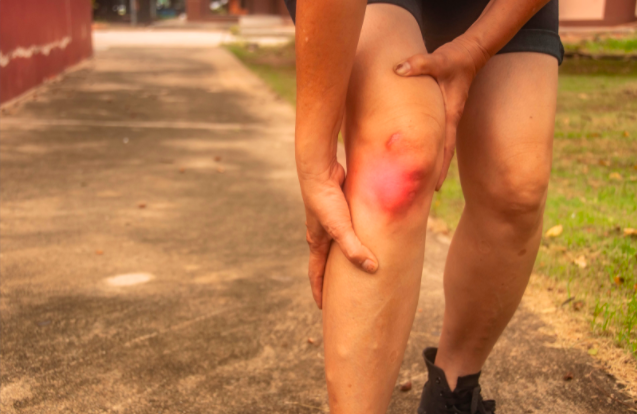Image by Image Source from Photo Images via Canva
The reality of participating in physical activity and exercise is that situations occur in which we place our knees in compromising positions.[1] This can be caused by sudden, direct blows to the joint, most of the time with no contact involved.[2] Of these knee injuries a torn ACL is one of the most common. Refer to this blog for more information on what an ACL is and how exactly tears can occur.
Let me strongly recommend that if you have injured your knee please have it assessed and treated by a healthcare provider. The intention of this blog is not to guess if you tore your ACL but to give you relevant health information so that you can make the best choices for the health of your knee. Unfortunately, it is common for ACL injuries to go unattended for several days, weeks or even months after the initial incident. This blog aims to provide readers with common signs and symptoms to watch out for following knee injury that could potentially be a torn ACL.
1) The "Pop"
One of the most common things that people talk about when they tear their ACL is a “popping” noise or a very apparent snap that is heard at the time of their knee injury.[3] This sound is likely the actual ACL tearing apart. This occurs during movements that involve suddenly slowing down and changing direction (cutting), pivoting on a firmly planted foot, landing awkwardly from a jump, stopping suddenly or receiving a direct blow to or collision with the knee joint.[3] Hearing a pop is not a guarantee that you tore your ACL but it does require your knee joint to be assessed by a healthcare provider.
2) Pain
Complete tears of the ACL are often extremely painful, especially in the first few minutes of injury.[4] It is important to note that the experience of pain is different for everyone. This means that the amount of pain you feel does not necessarily relate to how severe your ACL injury could be. Furthermore, pain associated with ACL injuries is fairly hard to localise meaning that you can’t exactly pinpoint where in the knee the pain is coming from, it sort of just hurts everywhere. In most cases, the pain is bad enough that people are not able to continue their sport or physical activity immediately after tearing an ACL.

Image by Mungkhoodstudio's Images via Canva - Pain associated with ACL injuries are hard to localise
3) Swelling
The amount of swelling and the time in which the swelling begins is another important sign that can indicate a potentially torn ACL. With an ACL tear the swelling is quite significant and will likely occur within minutes of the injury. When the ACL is torn, the many blood vessels that feed the ligament can fill the knee’s joint space with blood, this is medically referred to as hemarthrosis.[5] As the hemarthrosis continues the swelling will become more obvious and develop significantly within 1 to 2 hours following the injury, resulting in a very “puffy” knee.[4]
4) Knee Instability
As the primary stabilizing structure within our knee, a torn ACL will inevitably result in knee instability or a feeling of your knee “giving out”.[3] This instability can be noticed in cutting or pivoting movements however it is possible that it can occur during less complex movements such as simply walking, or activities of daily living like getting into and out of your car.[5] It is important to take note that returning to movements that promote instability of the knee can cause further damage to the joint, which is why it becomes important to have your knee assessed by a healthcare provider.
5) Decresed Range of Motion
Range of motion is a fancy term referring to the amount of movement we have in our knee joint in different directions. The 4 signs and symptoms above definitely contribute to the reduction in knee movement that will come from a torn ACL. Most people will show up to a doctor between 24 to 48 hours after their injury when pain and swelling is quite intense, however the best time to be examined for an ACL tear is within the first hour following the injury so that movement of the knee can more accurately be examined.[4]

Image by sarun rodjanaudomwuttikul via Canva - Swelling and knee instability are common with ACL tears
Conclusion
So what are the signs and symptoms that indicate a potential ACL tear? Even though the injury experience can be different for everyone the 5 most common signs and symptoms are:
5) A reduction in knee range of motion
By being able to identify common signs and symptoms associated with a torn ACL, the hope is that you can more rapidly understand the severity of your potential injury which will allow you to seek health care sooner. The sooner you seek professional help, the faster you can begin your journey towards ACL recovery. The Curovate app is one of the leading physical therapy apps designed to make physical therapy more accessible. For additonal tips and daily exercises after your knee replacement download Curovate for knee replacement recovery below. Our physical therapy app is for ACL, knee replacement, or hip replacement recovery. It provides you with guided exercises, rehab reminders, progress tracking, and can even measure your range of motion, all from the convenience of your phone. Click on the links below!
If you need further customized assistance during your surgery or injury recovery check out our Virtual Physical Therapy page to book your 1-on-1 video session with a physical therapist.
 |
 |
|---|
Other Blogs Related to ACL Injury
- After ACL surgery, how much help will I need? And help with what?
- Am I at risk of tearing my ACL? How can I prevent an ACL injury? How can I avoid reinjury to my ACL?
- Did I retear my ACL graft?
- Can an ACL injury lead to arthritis in the future?
- What is an ACL and How is it Injured?
References







